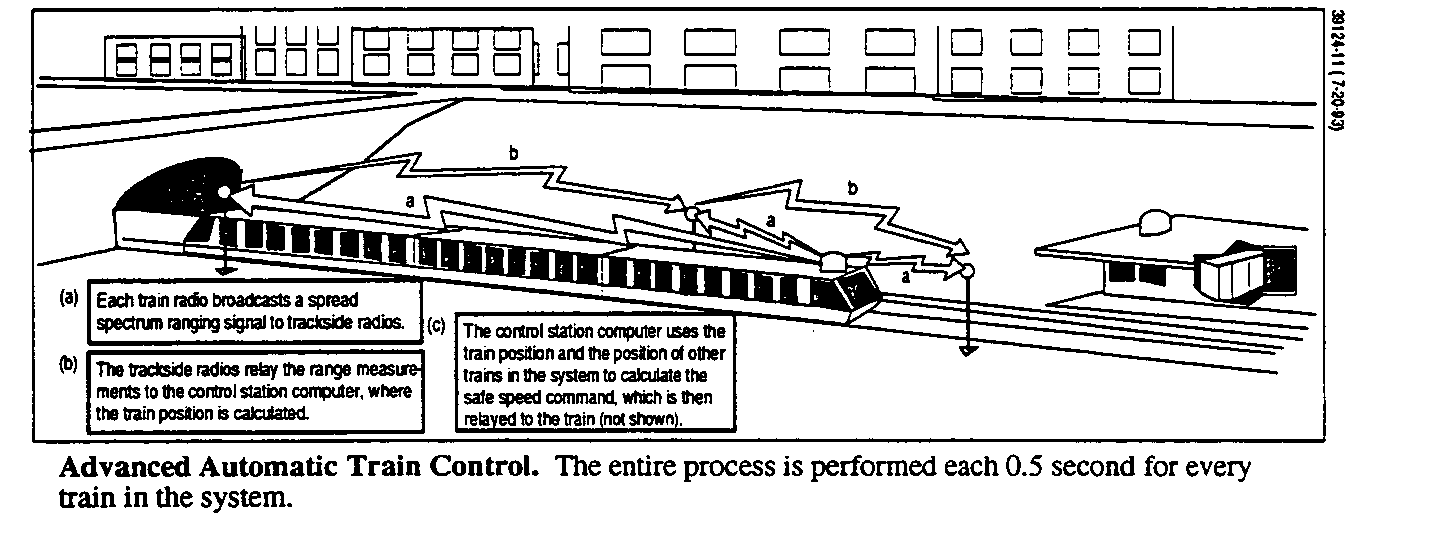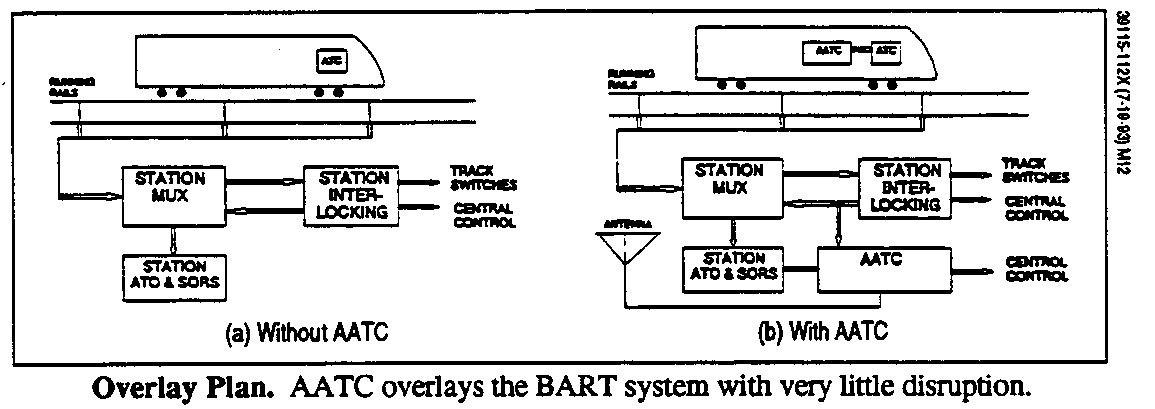Advanced Automatic Train Control (AATC): BART's 1990s goal of CBTC
|
A program to replace BART's original Westinghouse Automatic Train Control (ATC) never produced a product used for revenue service. AATC was an attempt at a new train control system (using "Desert Storm" military technology) to allow for closer trains on the M line and upper A line, allowing for higher capacity in the same amount of space during peak hours. The late 1990s contract was intended to do away with track circuts and rely on radio ranging technology to locate trains. Multiple issues, alongside company mergers, resulted in the project never completing. BART sued General Electric, the sucessor company for breach of contract and reached an agreement with GE outside of court.
The only traces visible to the naked eye of the AATC project are AATC poles littering the right of way from Bay Fair to Oakland, San Francisco, and Daly City, alongside mods to the legacy fleet cars. |
Further details on AATC (Articles)
Clinton Awards BART High-Tech Defense ‘Conversion' Money
BART News Release, 1994
The White House today announced the award of $19.5 million in Defense Conversion funds to an alliance of BART, Hughes Aircraft and Morrison Knudsen Corp. to develop an Advanced Automatic Train Control System (AATC). The new system will nearly double the current number of passengers BART can carry during the congested morning and evening commutes and eliminate the need for a second, multi-billion transbay tube.
Current train control technology and design limits operating headways to one train every 3 3/4 minutes. The new AATC technology will allow BART to operate trains at two minute frequencies. This added capacity means that BART will be able to carry approximately 60,000 additional passengers during the morning and evening commute periods — from the current rate of 16 trains per hour to 30 trains per hour.
The 21st Century AATC system would convert the U.S. military's radio frequency position locating defense technology that was successfully used by U.S. forces during the Persian Gulf conflict to track equipment and troops, to pinpoint a speeding BART train to within 15 feet of its location — including inside the TransBay Tube.
Reducing the intervals would let BART have more trains in the TransBay Tube at the same time, thus increasing the system's capacity. Increasing the capacity of the existing system would obviate the need for a second TransBay Tube.
The new AATC system would also allow BART trains to use electricity more efficiently, thus reducing electricity consumption on the all-electric system. Accurate positioning of trains would also allow the trains to maintain higher average speeds.
"This technology is BART's future," said BART Board President. Margaret K. Pryor.
"This removes the existing major impediment to increasing BART's passenger-carrying capacity. Not only will BART be able to serve more people of the Bay Area — and serve them with better, faster transit — but we'll also save money on expanding the system; reduce air pollution and energy consumption; help to create housands of new, good paying jobs, and make California the hub of high-tech transit technology."
BART, Hughes Aircraft and Morrison Knudsen have already formed an alliance to convert the technology from military to civilian use and to apply it to transit. In addition to the specific benefit to BART, significant national and international markets exist for this technology.
Hughes and MK were selected by BART through a competitive process to design and demonstrate this equipment. With the receipt of these funds, BART can now proceed with the award of a contract to begin implementation of this work.
BART will help design and implement the system. Orange County-based Hughes will modify the military equipment, generate the control software and oversee system design and testing. Morrison Knudsen, the only manufacturer of rail cars in the United States, will integrate the technology into train cars and control stations. Morrison Knudsen is building 80 BART cars at a newly opened facility in Pittsburg in East Contra Costa County.
Hughes and Morrison Knudsen have already formed and invested in a joint venture company to pursue the market and to make the investments that will be required to develop business.
"Naturally I'm delighted to see the White House and the Clinton Administration recognize BART's standing as a natural conduit for military conversions to commercial applications," said BART General Manager Frank J. Wilson. "It shows, once again, that BART is on the cutting edge of transit not just in the United States, but throughout the world. It also shows the worth of BART's investment in R&D. BART was one of the first transit systems in the United States to set up its own in-house research and development department. And this investment has now paid off handsomely by attracting significant amounts of federal grants to leverage BART's relatively small investment."
BART, Hughes and Morrison Knudsen will match the federal grant in cash and in-kind contributions. The grant announced today covers the first two phases of the work.
Phase I entails design and testing at BART's test track in Hayward. Phase II expands the program to include revenue-service testing on a portion of BART's main line system. Phase III, which would require another $32 million federal grant, entails revenue-system installation.
"The federal government's money will be recouped handsomely through sales to other transit systems in the United States and around the world," Wilson said. 'BART will recoup its investment many times over through increased patronage and elimination of the need for a second, multi-billion TransBay Tube."
The funds are part of the President Clinton's "Technology Reinvestment Project," which is a cornerstone of his Defense Reinvestment Conversion Initiative. They are intended to link the best of America's defense and commercial industries in creating new “dual-use" technologies with both commercial and military applications, prepare defense engineers and workers for the manufacturing industries of the future, and help small defense firms make the transition to commercial markets.
The joint application by BART, Hughes, and Morrison Knudsen got a big boost from
Rep. Ron Dellums, D-Berkeley, who chairs the House Armed Services Committee.
"Without his help, I don't know if BART would have been recognized," Pryor said.
"He has taken the lead in Congress in helping convert military spending and technology to jobs- and wealth-producing civilian commercial uses."
The request also got help from Rep. Anna Eshoo, D-Atherton, a member of the House Subcommittee on Science and Technology, and from Senators Diane Feinstein and Barbara Boxer. All four have worked tirelessly in Washington to resurrect California's economy, devoting special attention to the relationship between high-tech transit, the environment, energy conservation and the conversion of military technology.
There currently are no U.S. suppliers of radio frequency-based advanced automatic train control signaling equipment for the transit industry. Converting the new technology from military to commercial transit use would put the United States — and particularly California — on the cutting edge of 21st Century train control technology.
Analysts estimate a more than $1 billion market for the technology — in the United States alone. Within the next decade, the cities of New York, Philadelphia, Washington, D.C., Baltimore, Boston and Atlanta plan major investments in upgrades and extensions to systems that could use the AATC equipment.
Capturing just 50 percent of the U.S. transit market would sustain a business base of between $150 million and $300 million per year — most of it in California. In addition, modules developed for the AATC would be structured for "dual use" — to meet both civilian and military requirements. The business base would create and support thousands of good-paying, high-tech jobs in the state, from Silicon Valley to the hard-hit former defense industry center of Southern California.
Worldwide, the market is even greater as emerging industrial and electronics-driven nations build urban and rail systems to serve their growing industries. Both Japan and the industrialized nations of Europe are already working on advanced train detection and fixed-rail guidance systems akin to AATC.
Modeled after the successful Global Positioning Satellite defense technology, AATC entails placing radio transmitters and receivers alongside BART tracks and in the lead and tail cars of BART trains. Radios at the control stations communicate with the trains via radios installed at 1/3-mile to 1-mile intervals along the track.
Messages are sent and received between the vehicle and the trackside radios every ½ second, with each trackside radio calculating the time it takes for the signal to get from a vehicle radio to itself. The time is then directly converted to a distance between the trackside radio and the train and train reports are sent to the control stations where speed commands are selected and relayed back to the train. The position of a train traveling at 80 mph can then be pinpointed to within 15 feet.
Additionally, the new AATC will overlay BART's existing Automatic Train Control system, leaving the existing system to support precise monitoring and direct performance comparisons, and to act as a backup to ensure a safe, graceful transition to the 21st Century technology.
In making the announcement from the White House, President Clinton, joined by Secretary of Defense William Perry, said, "This marks another major step in our effort to protect our national security and promote our economic security in the post-Cold War world. We are investing in projects that will create the jobs of the future by exploring ideas, developing technologies, creating products and strengthening skills that will keep America strong, militarily and economically."
The BART/Hughes/Morrison Knudsen grant was one of only 212 technology conversion grants approved by the White House — out of nearly 3,000 applicants from across the country.





